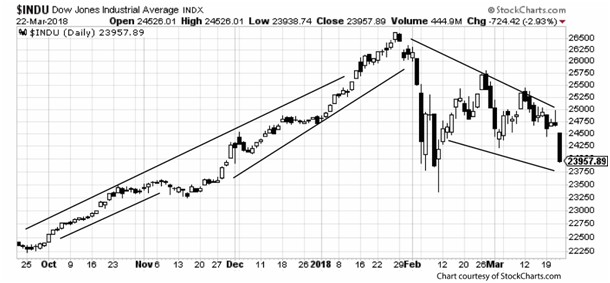
Traders trends to be absolute in their faithfulness. They might believe in tracking the Black-Scholes pricing model even with its well-known inaccuracy, or in calculating implied volatility even with its questionable and unknown quantity called “risk-free interest rate.” Anyone who disagrees with adherence to these methods is considered a heretic.
Another sect of the options faithful relies on underlying volatility to judge option valuation and also to time trades. This group looks for trends in historical volatility in order to time trades. Because volatility goes through cycles, with decreases following increases and vice versa, timing based on historical volatility is a reasonable tactic in deciding when to enter or exit trades.
The simplified “rule” is to sell options when volatility is high (because this also means option premium is rich) and to buy when volatility is low (because option premium tends to be depressed), so traders using timing based on historical volatility – assuming comparisons are made based on similar moneyness and expiration timing – is not unreasonable.
For example, look at how the Dow Jones Industrial Average (DJIA) has been behaving recently. The financial news announces the biggest-ever price drop in a single day, the loss of billions of dollars in market value, and the gut reaction of the market to economic news. But from a technical point of view, does any of this matter for the long term?
The Dow, we should remember, is not a singular market force, but the net of 30 different companies. These may move through volatility cycles in a similar and collective manner, as seen recently, but traders also have to remember the often observed reality: Volatility changes, but it also goes back and forth over a period of time. For example, look at the six-month chart for the DJIA.

For the first four months shown on the chart, the channel was exceptionally narrow, and the price trend was remarkably consistent. Given that the value of the index is between 22,250 and 26,500 on this chart, the 500-point channel was remarkable over a four-month period.
The last two months presented a different story. The trading range was as high as 3,000 points and even when the early February volatility settled down, the bearish channel narrowed only slightly, with recent trading range about 1,250 points.
The change in volatility is noteworthy – and visible. For those traders deeply concerned about the “end of the trend” and the unexpected explosion in volatility, it is worth remembering that volatility itself is cyclical, just like price direction. These big moves over 1,000 points over only a few days is unlikely to continue indefinitely. Volatility will calm down once the impact of recent news is absorbed. The president’s decision to impose tariffs on Chinese imports is deeply concerning to the markets, but this economic news tends to have only short-term impact on volatility.
The news dominates equally important economic news including reduced tax rates, improved employment news, and much more. We also cannot know the outcome of the possible tariff war. Since it benefits no one, it could be that tariffs will be canceled with a revised trade agreement, and that the long-term impact on the markets will be positive rather than negative.
The situation at the moment, in which depressed stock prices have caused panic and retreat from the market among many institutions and individuals, is a passing volatility trend. The unending tendency to “buy high and sell low” (instead of the other way around) repeats itself time again. For options traders who are aware of the evolving nature of historical volatility, when the markets are unsettled as they have been in recent weeks, this presents an exceptional trading opportunity.
Options traders who consider themselves hedger rather than speculators, and who act as contrarians, will be able to recognize the opportunity this market presents. High volatility is “bargain-hunting season” for options traders, based on the easily observed changes in historical volatility.



There are no comments to display.
Join the conversation
You can post now and register later. If you have an account, sign in now to post with your account.
Note: Your post will require moderator approval before it will be visible.